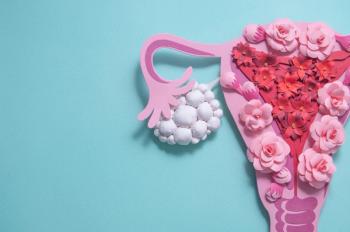In a recent study, the investigational non-hormonal vaginal contraceptive Ovaprene (Dare Bioscience) met the criterion for contraceptive effect in all participants.
Takeaways
- Ovaprene, an investigational non-hormonal vaginal contraceptive, demonstrated consistent contraceptive effectiveness in all participants of a recent study.
- The contraceptive mechanism of Ovaprene involves a silicone ring with a permeable barrier, releasing ferrous gluconate to induce spermiostasis and prevent sperm movement.
- Clinician fitting is unnecessary for Ovaprene, which is inserted at the end of one menstrual period until the beginning of the next, simplifying contraceptive use.
- Postcoital tests confirmed Ovaprene's efficacy in preventing sperm penetration into midcycle cervical mucus, with successful results across multiple cycles.
- The study's findings support the initiation of a pivotal trial to further evaluate Ovaprene's contraceptive effectiveness over an extended period in individuals at risk of pregnancy.
Ovaprene includes a 55 mm silicone ring with a central permeable barrier, allowing fluid passage while limiting sperm movement. Spermiostasis is achieved through ferrous gluconate release by the ring, leading to oxidative damage in the sperm tail.
Clinician fitting is not required for Ovaprene, and it is inserted at the end of one menstrual period until the beginning of the next, eliminating the need for action during intercourse. To test the efficacy of a vaginal contraceptive, a postcoital test evaluating sperm entry into the cervical mucus should be performed.
In postcoital tests, a minimum number of high-power field (HPF) should be present. Investigators conducted a postcoital test to evaluate the efficacy of Ovaprene for preventing midcycle cervical mucus penetration from sperm, as well as the fit and ease of placement.
Participants included sexually active women with regular menstrual cycles not at risk of pregnancy. Their male partners were also included in the analysis.
Women attended 21 visits across 5 menstrual cycles including a baseline postcoital test cycle, diaphragm postcoital test cycle, Ovaprene safety, ferrous gluconate release, and acceptability assessment cycle, and 2 Ovaprene postcoital test cycles. Changes in postcoital test results were reported as the primary outcome of the analysis.
During the first cycle, baseline information was obtained. The contraceptive surrogate effect of the postcoital test was demonstrated during the second cycle. No intercourse actions occurred during the third cycle, but intercourse at the time of ovulation was evaluated during the Ovaprene postcoital test cycles.
Data about menses, intercourse, intravaginal product use, adverse events (AEs), medications, and device issues was obtained through participant self-report in a web-based electronic diary. Investigators performed evaluations of cervical mucus during the Cervical Mucus Check visit.
The fit and placement of Ovaprene were evaluated as tertiary outcomes. Fit was evaluated based on a digital and speculum exam, with criteria including covering the cervix, not protruding outside the introitus, not easily dislodge, and not causing discomfort.
There were 38 participants enrolled into the trial, 35 of whom completed the diaphragm cycle, 26 at least 1 Ovaprene cycle, and 23 all 5 cycles. Non-severe AEs and withdrawing consent were cited as the most common reasons for discontinuation. No severe AEs were reported.
Vaginal delivery was reported by 65.4% of patients completing an Ovaprene cycle and vaginal contraceptive ring use by 42.3%. Under 5 progressively motile sperm/HPF were reported for participants in all diaphragm cycles and all Ovaprene cycles, indicating successful postcoital test regardless of covariates.
During the baseline cycle, a mean 27.2 progressively motile sperm/HPF was reported. This number was reduced to 0.5 progressively motile sperm/HPF in the Ovaprene cycles.
When modifying the required mucus score with a successful cervical mucus check defined as the absence of sperm regardless of score, a score over 10 was reported in 63.6% of Ovaprene cycles. In comparison, this score was reported in 82.9% of baseline and Caya cycles combined.
During the third visit in the baseline test cycle, an ability to insert Ovaprene with written instruction only was observed for 86.7% of participants, position for 80%, and remove for 73.3%. Successful inserting, positioning, and removal was reported by all patients in subsequent visits, except for one who required verbal instructions.
These results indicated successful contraceptive effect from Ovaprene during all postcoital test cycles. Following these results, a pivotal trial is being conducted to assess the device across 13 cycles in patients at risk of pregnancy.
Reference
Mauck C, Thurman A, Jensen JT. Successful postcoital testing of Ovaprene: An investigational non-hormonal monthly vaginal contraceptive. Contraception. 2024;132. doi:10.1016/j.contraception.2024.110373

















